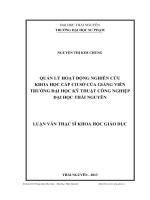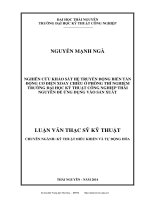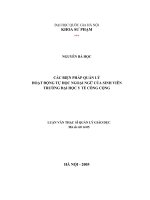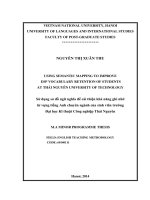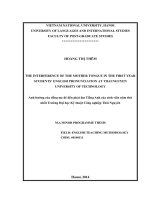Sử dụng sơ đồ ngữ nghĩa để cải thiện khả năng ghi nhớ từ vựng tiếng Anh chuyên ngành của sinh viên trường Đại học Kĩ thuật Công nghiệp Thái Nguyên
Bạn đang xem bản rút gọn của tài liệu. Xem và tải ngay bản đầy đủ của tài liệu tại đây (1.19 MB, 58 trang )
VIETNAM NATIONAL UNIVERSITY, HANOI
UNIVERSITY OF LANGUAGES AND INTERNATIONAL STUDIES
FACULTY OF POST-GRADUATE STUDIES
*********************
NGUYỄN THỊ XUÂN THU
USING SEMANTIC MAPPING TO IMPROVE
ESP VOCABULARY RETENTION OF STUDENTS
AT THÁI NGUYÊN UNIVERSITY OF TECHNOLOGY
Sử dụng sơ đồ ngữ nghĩa để cải thiện khả năng ghi nhớ
từ vựng tiếng Anh chuyên ngành của sinh viên trường
Đại học Kĩ thuật Công nghiệp Thái Nguyên
M.A MINOR PROGRAMME THESIS
FIELD: ENGLISH TEACHING METHODOLOGY
CODE: 60140111
Hanoi, 2014
VIETNAM NATIONAL UNIVERSITY, HANOI
UNIVERSITY OF LANGUAGES AND INTERNATIONAL STUDIES
FACULTY OF POST-GRADUATE STUDIES
*********************
NGUYỄN THỊ XUÂN THU
USING SEMANTIC MAPPING TO IMPROVE
ESP VOCABULARY RETENTION OF STUDENTS
AT THÁI NGUYÊN UNIVERSITY OF TECHNOLOGY
Sử dụng sơ đồ ngữ nghĩa để cải thiện khả năng ghi nhớ
từ vựng tiếng Anh chuyên ngành của sinh viên trường
Đại học Kĩ thuật Công nghiệp Thái Nguyên
M.A MINOR PROGRAMME THESIS
FIELD: ENGLISH TEACHING METHODOLOGY
CODE: 60140111
SUPERVISOR: NGÔ HỮU HOÀNG, PhD.
Hanoi, 2014
i
DECLARATION
***
I, Nguyễn Thị Xuân Thu, hereby certify that this minor thesis entitled
USING SEMANTIC MAPPING TO IMPROVE
ESP VOCABULARY RETENTION OF STUDENTS
AT THÁI NGUYÊN UNIVERSITY OF TECHNOLOGY
is completely the result of my own word for the Degree of Master at University of
Languages and International Studies, Vietnam National University, Hanoi and that
this thesis has not been submitted for any degree at any other university or
institution.
Signature
Nguyễn Thị Xuân Thu
ii
ACKNOWLEDGEMENTS
This thesis could not have been accomplished without the help,
encouragement and support of many people who all deserve my sincerest gratitude
and appreciation.
First and foremost, I would like to express my deepest gratitude to my
supervisor, Dr Ngô Hữu Hoàng, for his priceless support, wholehearted guidance
and encouragement during the time I conducted this research.
I would like to send my thanks to my colleagues who help me a lot in with
their experiences during my thesis.
My special thanks also go to the students from class K41M at Thainguyen
University of Technology for their willingness to join my treatment, taking part in
the tests and answering my questionnaire. Without their help, this study could not
be finished.
Finally, I owe a great debt of gratitude to my beloved family – my mother,
my husband, my children, whose support and encouragement helped me a lot to
overcome all problems to complete this thesis.
Nguyễn Thị Xuân Thu
iii
ABSTRACT
This study was conducted as an action research in which semantic mapping
was applied as a technique in learning English for specific purposes (ESP)
vocabulary. The study aimed at evaluating the improvement of students’ vocabulary
retention with the help of semantic mapping and collecting students’ attitudes
towards this technique, and their own suggestions for a better future teaching and
learning program. For the accomplishments of these purposes, 22 students in one
class at Thái Nguyên University of Technology in Vietnam were involved in the
study. The data instruments included a semi-structured group interview, Vocabulary
Knowledge Scale (VKS) tests considered as two progress tests and a final test, and a
questionnaire. Through the semi-structured group interview, the results revealed
that among many obstacles students encountered in their vocabulary learning, lack
of remembering techniques was the biggest problem. Realizing the specific
problem, the researcher made a plan in the intervention phase. Semantic mapping
was applied in the whole course whenever necessary. After four weeks of treatment,
the checking and evaluation were conducted through a VKS test. The first progress
test did not show a good result as mean score was only 2.74. However, the result
from the second progress test was much better. The final test also revealed a good
result. The data analysis and evaluation helped to prove the effectiveness of using
semantic mapping in both short-term and long-term vocabulary retention. A
questionnaire was also used to investigate students’ attitudes and suggestions. Their
positive attitudes towards semantic mapping and their suggestions showed that
semantic mapping could be applied in a bigger scale. On this basis, the study gave
some recommendation and future research.
iv
LIST OF TABLES AND FIGURES
FIGURES Page
Figure 1: A sample semantic map 8
Figure 2: The data collection procedures 15
Figure 3: Individuals’ result from progress test 1 20
Figure 4: Percentage of the whole class’s scores in the progress test 1 21
Figure 5: The whole class’s performance in progress test 1 and progress test 2 22
Figure 6: Percentage of each score in progress test 1, 2 and final test 27
Figure 7: The whole class’s performance in the progress test 1, 2, and final test 27
Figure 8: Importance of semantic mapping 30
Figure 9: Effectiveness of semantic mapping 30
Figure 10: Pleasure when using semantic mapping 31
TABLES
Table 1: Result from group interview 18
Table 2: Mean score gained by the whole class in the progress test 1 20
Table 3: Result of the whole class in the progress test 1 and progress test 2 22
Table 4: Mean scores gained by individuals in progress test 1 and progress test 2 24
Table 5: Result from progress test 1 and 2 25
Table 6: Result from progress test 2 and final test 25
Table 7: The whole class’s results from the two progress tests and the final test 26
Table 8: Mean scores gained by individuals in progress test 1, 2 and final test 28
Table 9: Students’ suggestions about vocabulary learning 30
v
TABLE OF CONTENTS
Page
Declaration i
Acknowledgement ii
Abstract iii
List of tables and figures iv
Table of Contents v
Part A: Introduction 1
1. Rationale for the study 1
2. Objectives and research questions of the study 2
3. Scope of the study 2
4. Significance of the study 2
5. Methods of the study 3
6. Design of the study 3
Part B: Development 5
Chapter 1: Literature review 5
1.1 The importance of vocabulary in second language learning 5
1.2 ESP vocabulary 5
1.3 Semantic mapping as a strategy to improve vocabulary retention 6
1.3.1 Definition 6
1.3.2 Procedures to construct a semantic map 7
1.3.3 Advantages of semantic mapping in teaching vocabulary 8
1.4 Previous related studies about semantic mapping in teaching vocabulary 8
Chapter 2: Research methodology 10
2.1 The background of the study 10
2.1.1 The study setting 10
2.1.2 Participants 10
2.1.3 Materials 10
2.1.4 Features of mechanical engineering English 11
vi
2.2 Implementation of the action research 11
2.3 Data collection instruments 12
2.3.1 Interview 12
2.3.2 Vocabulary Knowledge Scale tests 13
2.3.3 Questionnaire 14
2.4 Data collection procedures 15
2.5 Data analysis method 17
Chapter 3: The study 18
3.1 Result from the interview 18
3.2 Results from the tests 19
3.2.1 Results from the first progress test 19
3.2.2 Results from the second progress test 21
3.2.3 Result from the final test 25
3.3 Results from the questionnaire 29
3.3.1 Students’ attitudes towards semantic mapping 29
3.3.2 Students’ suggestions 32
Part C: Conclusion 34
1.Conclusion remarks 34
2.Limitations of the study 35
3.Recommendations and suggestions for further study 35
REFERENCES 37
APPENDICES I
1
PART A: INTRODUCTION
1. Rationale for the study
During the recent years English for specific purposes (ESP) has become an
important subject in most vocational institutes. At Thái Nguyên University of
Technology (TNUT), ESP courses are also delivered to students to fulfill their
needs of studying English materials relevant to their majors including mechanical,
electrical, electronic, civil and environmental engineering.
English language involves four skills: listening, speaking, reading and
writing. In order to master those skills, vocabulary plays the vital role. No one can
deny the important part of vocabulary in language acquisition, especially in English,
either for general purposes or for specific purposes. Its significance is emphasized
by Wilkins (1972): “without grammar, very little can be conveyed; without
vocabulary, nothing can be conveyed”. Vocabulary is also considered the key
element of ESP according to Robinson (1991). Therefore, one of the most concerns
about ESP teaching at our university is how to help students learn vocabulary better
and improve their vocabulary intention. However, being a teacher of English, the
researcher has recognized some problems after students finish their ESP course.
The most common problem is that they usually forget what they have learnt,
especially vocabulary. That means their vocabulary retention is not good enough
and most students still waste a lot of time looking up the meaning of terminologies
even though they were delivered during the course. Lacks of vocabulary leads to
many difficulties in dealing with their majors because students are required to read
many English materials to look for further knowledge. The motivation for me to
carry out this study is helping students address their problem in vocabulary
retention. Semantic mapping is chosen as a new method in teaching ESP
vocabulary. How it improves my students’ learning and vocabulary retention is
what I want to find out after the study is finished. All the above-mentioned reasons
inspired me to conduct an action research titled “Using semantic mapping to
2
improve ESP vocabulary retention of students at Thái Nguyên University of
Technology”.
2. Objectives and research questions of the study
The objectives of the study are to explore the impact of semantic mapping in
improving students’ ESP vocabulary retention; and to find out the attitude of
students towards semantic mapping as a vocabulary learning technique. To achieve
those objectives, the study needs to answer two research questions:
1. Does semantic mapping help students improve their ESP vocabulary
retention?
2. What are the students’ attitudes towards semantic mapping and their
suggestions of semantic mapping as a vocabulary learning technique?
3. Scope of the study
The study firstly aims at finding out the influences of semantic mapping on
improving students’ ESP vocabulary learning as well as their vocabulary retention.
Students’ perception of semantic mapping is measured by questionnaire responses
and progress tests are used to clarify its impact on their vocabulary retention.
Secondly, this study is an action research project in a small scale since its first and
foremost purpose is to improve the researcher’s teaching. The study is conducted
with 22 third year students majored in mechanical engineering who are students in
the researcher’s class. Finally, the material used in this study is Oxford English for
Electrical and Mechanical engineering course book compiled by Eric
H.Glendinning and Norman Glendinning.
4. Significance of the study
Although semantic mapping is not a new approach in English teaching and
learning, little has been researched on ESP vocabulary learning. The findings of this
study may shed more light on the possibility of employing semantic mapping in
3
teaching ESP at TNUT. That was drawn from the students’ perceived benefits from
this vocabulary learning technique and their improvement in vocabulary retention.
What the researcher finds out has great impact on her teaching and it is expected
that this study will overcome the difficulties of students’ in memorizing their ESP
vocabulary and it can help the students be interested in learning vocabulary. The
study can be used a reference not only for teachers at TNUT but for those in other
universities as well.
5. Methods of the study
This study is actually an action research project. Its data collection instrument
includes a semi-structured interview, two progress tests and a final test in the format
of Vocabulary knowledge scale tests. Additionally, a questionnaire for the students
is employed. The interview helps the researcher identify the problem of her students.
The progress tests and final test are regarding to the first question about effects of the
treatment on students’ ESP vocabulary retention and the questionnaire is regarding
to the second question about students’ attitudes and suggestions in learning ESP
vocabulary through semantic mapping
6. Design of the study
The thesis is composed of three parts:
- Part A – Introduction – covers the rationale, the aims and objectives, the
scope, the research question, the significance, the methods, the design of the
study.
- Part B – Development – consists of three chapters. Chapter 1 provides the literature
review for the study. Chapter 2 covers the information about the context in which
the study is conducted, the participants, the research methods, the research
procedures including the treatment, methods of data collection and analysis. And
the last chapter deals with the study’s findings and discussions.
4
- Part C – Conclusion – summarizes the major findings with reference to the research
questions mentioned in Part A. This part includes the limitations of the study and
provides some recommendations and suggestions for further study.
5
PART B: DEVELOPMENT
CHAPTER 1: LITERATURE REVIEW
1.1 The importance of vocabulary in second language learning
It can be seen that the acquisition of vocabulary is a fundamental and
important component for most second language (L2) learners in their learning as Mc
Carthy (1990) stated:
“It is the experience of most language teachers that the single, biggest component
of any language course is vocabulary. No matter how well the student learns
grammar, no matter how successfully the sounds of L2 are mastered, without words
to express a wide range of meanings, communication in an L2 just cannot happen
in any meaningful way.”
Schmitt (2010) shared the same opinion: “Language vocabulary is essential
part of mastering a second language”.
A good mastery of vocabulary is essential for learners, especially for those
who learn English for specific purposes (ESP). “It is to direct vocabulary learning
to more specialized areas when learners have mastered the 2000-3000 words of
general usefulness in English” (Nation, 2001: 87). The mastery of vocabulary can
support them when they read technical documents or translate into their mother
tongue.
All the above quotations highly appreciate the important role of vocabulary
in language learning, especially in second language learning.
1.2 ESP vocabulary
English for specific purposes (ESP) has been defined by many writers and
researchers. Mackay and Mountford (1978) indicated that the term ESP is
generally used to refer to the teaching of English for a clear utilitarian purpose. El-
Minyawi (1984) pinpointed that ESP courses are based solidly upon the need to
express the facts and ideas of some special subjects after which the student should
be able to read the specialized subjects confidently and speak about them fluently.
Hutchinson and Waters (1987) defined it as an approach to language teaching in
6
which all decisions as to content and method are based on the learner’s reason for
learning, they added also that the term ESP implies that, it is English which is
somehow peculiar to the range of principles and procedures which define that
particular profession.
It is necessary to distinguish two types of ESP vocabulary:
- Technical vocabulary means lexis which is only used in the specialism.
- Sub-technical vocabulary means general lexis that has a higher frequency in
the specialism, sometimes with a specific or changed meaning.
Dudley-Evans and St John (1998) also suggested two broad areas:
- Vocabulary that is used in general language but has a higher frequency of
occurrence in a specific and technical description and discussion.
- Vocabulary that has specialized and restricted meanings in certain disciplines
and which may vary in meaning across disciplines.
It can be seen clearly that the first area would be referred to semi-technical
and the second would be regarded as technical vocabulary. For such
characteristics, ESP vocabulary is not easy for learners to remember and recall.
Vocabulary can cause many difficulties for students in understanding of
technical texts. As English words often have more than one meaning, students
would feel confused if they find some general words in a technical text but they do
not understand their meanings. “Examples of such words are cycle (cf. its use in the
carbon cycle or a cycle of electricity), conductor (in electricity), and resistance (in
an electrical circuit)”, according to Kennedy and Bolitho (1984:58)).
1.3 Semantic mapping as a strategy to improve vocabulary retention
1.3.1 Definition
According to Baleghizadeh and Naeim (2011), “semantic mapping falls
under the general category of graphic organizers and is used in different subjects
areas in order to help learners understand the relationships and form concepts about
broader topics”. The basis of semantic mapping is the relationship among its
7
elements (here, the words). Once this relationship is established, the learners will
remember them more easily.
Semantic mapping is an approach that can be used to exhibit the associations
between ideas. In vocabulary explicitly teaching, it can be used as a tool for
students to discover the relationships between vocabulary words. As semantic
mapping builds on prior knowledge, and is an active form of learning, it can be a
very effective teaching tool. Semantic mapping strategy has been considered a
highly regarded form of elaborative learning (Novak 2005; Nesbitt and Adescope
2006) which encourages a deeper learning process for better memory formation.
1.3.2 Procedures to construct a semantic map
Semantic mapping involves a graphic display, or in other words, it refers to
making an arrangement of words into pictures, which has a key concept linked with
related words by means of lines or arrows. First, students are presented with a
concept that is central to understanding a selection or a subject. Then they
brainstorm or freely associate words that are related to that concept. As students
brainstorm, the teacher writes their suggestions on the board, adding words they
need to learn.
The framework of semantic mapping includes: the concept word and
category examples. This is a very interactive process and should be modeled by the
teacher first. The steps involved in semantic mapping (cited in Phạm, 2012) are:
introduction of the topic, brainstorming activities, presentation of target words,
categorization, personalization, review of target words. Following is an example of
a semantic map:
8
Figure 1: A sample semantic map (Duffy)
1.3.3 Advantages of semantic mapping in teaching vocabulary
Duffy (2009) stated that semantic mapping is one way to explain how to
categorize word meanings. It remains essential to identify key attributes
distinguishing one word from another. But semantic maps provide the additional
benefit of helping students visualize how word meanings can be categorized.
The major purpose of the semantic map is to allow students to organize their
prior knowledge into these formal relations and thus to provide themselves a basis
for understanding what they are about to read and study. Comprehension can be
thought of as the elaboration and refinement of prior knowledge. What the semantic
map provides is a graphic structure of that knowledge to be used as the basis for
organizing new ideas as they are understood.
Semantic mapping is a good vehicle for students to share their work with the
class, thus becoming the teachers themselves. Teaching a concept to others will
increase student retention of information greatly. By discussing them as well as
writing them down, teachers are catering to different learning styles, and ensuring
that all students are increasing their knowledge of vocabulary.
1.4 Previous related studies about semantic mapping in teaching vocabulary
Semantic mapping has appeared in many studies, which means that it receives
much attention for its advantages. Some of recent studies are summarized as
follows:
9
Baleghizadeh and Naeim conducted a study entitled Enhancing Vocabulary
Retention through Semantic mapping in 2011. In their paper, semantic mapping is
introduced as a vocabulary presentation technique, which is believed to help
learners remember words better as they study, using semantic mapping. Its results
confirm that semantic mapping fosters vocabulary retention.
The findings of the study entitled The effect of teaching vocabulary through
semantic mapping on EFL learners’ awareness of vocabulary knowledge at AL
Imam Mohammed Ibin Saud Islamic University by Abdelrahman in 2013 revealed
that semantic mapping can be used as an efficient methodology for teaching
vocabulary, a technique which is effective for EFL learners.
A similar conclusion is drawn from the study The use of semantic mapping to
improve students’ vocabulary of Sianturi, Suhartono and Bunau from University
Potianak. Being conducted in the school year of 2012-2013, it showed that semantic
mapping is used effectively in teaching vocabulary and helps students in improving
their vocabulary.
In Vietnam, there is a minor thesis entitled “Using semantic mapping to
teach ESP vocabulary to final-year students of Finance and Accounting at Hanoi
Tourism College” by Phạm Thị Hạnh. The study aimed at exploring the teaching
ESP vocabulary through semantic mapping with reference to attitudes to, and
opinions of, this instructional strategy as well as vocabulary retention. It was
conducted with 38 final-year students of finance and accounting at Hanoi tourism
college. Major findings of this study revealed that semantic mapping fosters
vocabulary retention to some extent and students seemed to value this technique.
10
CHAPTER 2: RESEARCH METHODOLOGY
2.1. The background of the study
2.1.1. The study setting
The study was conducted at Thái Nguyên Universtity of Technology (TNUT)
in Thái Nguyên City, Vietnam. The English courses at TNUT includes General
English (GE) for the first and second year students and English for specific
purposes (ESP) for third year students who are majored in specific technical fields.
Students are obligatory to finish GE courses before attending ESP course.
English for mechanical engineering is one of ESP courses at TNUT. It is
designed for mechanical students. This course provides some basic knowledge
about mechanical engineering through technical texts and focuses mainly on
reading and writing skills. Thus vocabulary plays an important role in helping the
students fulfill the demand of the course.
2.1.2. Participants
The subjects of this study were twenty-two students aging from twenty to
twenty three, twenty boys and two girls. They all finish GE courses and most of
them are third year students.
The researcher in this study was also the teacher of this class, who has been
working as an English lecturer at TNUT for six years so far. In this action research,
she was the practitioner and the researcher at the same time. She was responsible for
the design and implementation of the semantic mapping in teaching ESP
vocabulary, and later collecting and analyzing the data.
2.1.3. Materials
All the vocabulary being taught in this course was taken from the book titled:
“Oxford English for Electrical and Mechanical Engineering” by Eric H.
Glendinning and Norman Glendinning (Oxford University Press). Each unit in the
book usually includes Tuning –in, Reading, Language Study, Writing, Technical
11
Reading. Vocabulary part was not a separated part from others. It can be taught
whenever necessary. However, because each unit covers a specific topic,
vocabulary therefore can be divided into specific groups according to the content of
the unit.
2.1.4. Features of mechanical engineering English (MEE)
MEE, a branch of ESP, of course, has its own features which differ from GE.
In this study, the researcher only mentions about English vocabulary used for
mechanical engineering. According to Chen Chao and Fang Li, MEE vocabulary
has two distinguished characteristics: there is “continual appearance of professional
or technical vocabulary” which are pure in meaning, narrow in application and
usually limited to a specific condition such as “mechanotron” or “tribology”; and
“wide use of semi-technical words”. Semi-technical words refer to those used both
in GE and MEE, which contribute to obstacles that students encounter when
learning ESP vocabulary since their meanings depend on the context.
For example, “die” means not alive in GE but it means
“a shaped block of metal or other hard material used to cut or form metal in adrop f
orge, press, or similar device/ a tool of metal, silicon carbide, or other hard material
with a conical holethrough which wires, rods, or tubes are drawn to reduce their dia
meter/tool for cutting external threads/ a casting mould giving accurate dimensions
and a good surface to the object cast” in MME. To find the suitable meaning of such
words is not always easy for students, especially when they do not have a good
memory retention.
2.2. Implementation of the Action Research
There are some reasons for the implementation of this action research
project.
Firstly, action research is situational, which means specific solutions can be
given to specific problems in each context. In this study, the researcher (also the
12
teacher) recognizes that her students have troubles in remembering ESP vocabulary
so she decides to find the solution to improve the situation. The advantages here
include time, students’ natural performance, direct treatment and observation.
Secondly, it is a good chance for researcher to evaluate the treatment to find
out the rising problem and give timely decision for changing. In this study, the
treatment is carried out twice, as the results from the first progress test is not very
good as expected. The researcher after analyzing the data decides to do the
treatment in another phase to collect data, which leads to better results.
Despite the advantages, the study still had some limitations. The treatment
may work well in one class but may not be applied to other classes in different
contexts. If the same study is carried out in another class, the results obtained may
not be as effective as expected. Briefly, action research lacks generalization.
2.3. Data collection instruments
This study used an interview, three tests in the format of VKS tests which
served as two progress tests, a final test, and a questionnaire to collect data.
2.3.1 Interview
Semi -structured interviews are in-depth interviews. A semi-structured
interview will involve many open-ended questions, although they may also contain
some closed questions. A semi- structured interview was also chosen because it was
considered a feasible way to identify the problem in conducting an action research
like this.
The semi- structured interview was carried out within the group. As Michael J.
Wallace stated in his book “Action Research for Language Teacher” (1998) that
“most interviews are one- to- one, but it is also possible to have an “interview”
with a group, which could take the form of a kind of structured discussion”. In this
research, semi-structured interview is chosen as it appears as a small free-talk
between teacher and students in a comfortable and friendly environment.
13
The interview at the first week of the course included two sets of questions:
closed and open-ended questions. The open-ended one was “How often do you
learn vocabulary at home?”, “How do you learn vocabulary to remember them?”
and the closed one was “Do you often have difficulties in learning ESP
vocabulary? If yes, what are they?” Apart from these questions, a series of other
small questions were included according to the content of students’ answers to
collect the exact information.
2.3.2 Vocabulary Knowledge Scale tests
During the recent years, the Vocabulary Knowledge Scale (VKS) of Wesche
& Paribakht (1996) has gained significant popularity in second language vocabulary
assessment and is being used in a variety of studies (Waring, 2002, cited from
Nemalt, 2009). This VKS aims at checking students’ understanding of vocabulary
that they learned. It is a 5-point self-report scale that allows students self-report the
knowledge of a word like this:
1. I don’t remember having seen this word before.
2. I have seen this word before but I don’t know what it means.
3. I have seen this word before and I think it means…………
4. I know this word; it means …
5. I can use this word in a sentence, e.g………………………….
In this thesis, VKS was used as the form of the two progress tests and the
final test. These tests were employed to measure the effectiveness of applying
semantic mapping in learning vocabulary.
Progress test 1 and 2 were used to measure the short-term improvement of
the students. Immediately after finishing four weeks of treatment, progress test 1
was administered. The test was in the format of a VKS test which aimed at
measuring how well students know the word. This VKS test included 50 words
taken intentionally from the topics which students already learned. Progress test 2
14
was delivered at the final week of the course, which also include 50 words from the
topics in the course book.
Final test was delivered two weeks after the course. This is also a VKS test,
including 25 words from progress test 1 and 25 words from progress test 2. This test
is also called a delayed test, “Results from this delayed recall after two weeks is
normally referred to long-term retention” according to Yongqi (2003, cited in
Nemalt, 2009).
2.3.3. Questionnaire
Questionnaire was also another instrument for collecting data in this study.
In the words of Brown (2000, cited in Dörnyei (2003)), questionnaires are “any
written instruments that present respondents with a series of questions or statements
to which they are to react either by writing out their answers of selecting from
among existing answers”.
The questionnaire in this study was used in order to investigate students’
attitudes towards the application of semantic mapping in learning ESP vocabulary.
It was delivered to the students immediately after they finish the final test. There
were two main parts in the questionnaire, namely: (1) the students’ attitudes towards
semantic mapping in vocabulary learning, and (2) the students’ suggestions about
the application of semantic mapping in the future.
In the first part, students were expected to complete three questions to express
their attitudes in terms of the importance, the effectiveness and the pleasure of the
treatment. These questions were designed under the format of a Likert-scale (see
Appendix 5). In second part, the suggestions were given under the form of four
statements; the students would share their ideas by ticking in the suitable categories.
There are five levels of agreements: strongly agree, agree, not sure, disagree and
strongly disagree.
15
Based on the information and results collected from the questionnaire, the
teacher- researcher had a reliable basis to decide whether to go on applying
semantic mapping in the future or not.
2.4. Data collection procedure
Here are the basic steps in doing an action search project according to Nunan
(2001):
● Step1: Initiation
● Step 2: Preliminary investigation
● Step 3: Hypotheses
● Step 4: Intervention
● Step 5: Evaluation
● Step 6: Dissemination
● Step 7: Follow-up
However, to make it easy for the researcher, those 7 steps are simplified into 4
steps: problem identification –intervention – evaluation – reflection, which are
described in 4 phases. Figure 2 below illustrates the procedures of collecting data
for the study:
Figure 5: Data collection procedure
Figure 2: The data collection procedures
Phase 1: This phase is the problem identification step. The very first task in
this phase was to investigate the problems that students often encounter when they
16
deal with vocabulary. To fulfill this task, a semi- structured group interview was
carried out.
In order to create a comfortable atmosphere in the classroom, the group
interview was delivered at the beginning of the second session in week 1. Together
with the two main questions to keep students on the right track, follow- up
questions and some prompts were provided in order to orientate the interviewees
and prevent them from presenting irrelevant information. Students had a chance to
discuss and share their own problems, and teacher took time to ask detailed
questions and take notes. It took about 30 minutes for the group interview to be
completed.
Phase 2: After the results from this interview were analyzed, the study came
to phase 2 – intervention. From week 2 to week 6, the researcher planned and
conducted the treatment in which the students were introduced and explained about
semantic mapping during their lessons. Before learning a new topic, students were
asked to brainstorm about words relevant to the topic. The teacher then summarized
and constructed a sample semantic map for the topic. After the lesson, students
would have to revise all the new words given in the lesson in their own ways by
using semantic mapping. In the review session, the teacher then called some of her
students to stand up and describe how they had learnt the required word. This kind
of checking was also used as one good way to help asserting the result of the
research. Sample semantic maps used in the treatment could be seen in Appendix 1.
After four weeks, the first progress test was delivered to check student’s short-term
memory. This test included 50 words from unit 1 to unit 5 in the course book
(Appendix 2).
Phase 3: After collecting data from progress test 1, the teacher brought the
study to phase 3. From week 7 to week 12, the procedure was the same with phase
2. The progress test 2 was administered at the final week of the course. The test
consisted of 50 words from unit 6 to unit 11 in the course book (Appendix 3). This
17
test also aimed at checking short-term retention of the students after the same
amount of treatment time with phase 2.
Phase 4: The final test was delivered two weeks after the course ended. The
teacher arranged a class gathering before the examination due date and delivered the
final test. The final test was the combination of 25 words from progress test 1 and
25 other words from progress test 2 (Appendix 4). The questionnaire on students’
attitudes and suggestions for future usage of semantic mapping was distributed right
after they finished the final test (Appendix 5). At this meeting the teacher also
answered all the questions of the students about the preparation for the examination.
The evaluation step of the project is conducted after the collected data are
analyzed. After that, the reflection step is shown in the results of the project.
2.5. Data analysis methods
Regarding to the first research question, in the VKS progress and final tests,
the students would mark the given word from score 1 to score 5 (Appendix 2, 3, 4).
Mean scores in each test were then calculated. Both the performances of the total
class and individuals were then indicated by comparing mean scores between the
two progress tests and the final test. By this way, the improvement of students’
vocabulary retention in short term and long term could be revealed.
For the second research question, the data from questionnaire was
independently analyzed according to two different parts. The first part included
three smaller questions addressing three aspects of attitudes towards semantic
mapping, namely the importance, the effectiveness and the pleasure. For each
question, the researcher then used percentage to illustrate the data and presented
them in three different pie-charts. In the second part, data was counted, illustrated
by percentages and displayed in a table so that the researcher could make a
conclusion of ideas and opinions perceived by the students.




